Day 1 of a three day Early Summer Tour today. It was bright with some sunshine to start, clouding over through the morning and starting to rain early afternoon. The rain was only light though, not heavy as was the forecast, so it didn’t stop us.
We headed over to Snettisham for the morning. A Sedge Warbler was singing noisily from the brambles nearby as we got out of the minibus. A Greenfinch was wheezing from one of the gardens as we walked up the road. we made our way in on the path in through the bushes. We could hear a Lesser Whitethroat rattling over to one side, so we walked round and had a couple of glimpses of it flicking around in the brambles. There was a selection of other warblers, singing here – Common Whitethroat, Chiffchaff, and a Cetti’s Warbler shouting. We listened to the metronomic song of song of the Reed Warblers vs the mad chatter of the Sedge Warblers.
A Turtle Dove started purring nearby, deep in the dense bushes. We walked a bit further along to see if we could find an angle to see it, when it flew up and broke into a long gentle glide back down, its display flight. We saw where it landed this time, high in a pine tree, and got it in the scopes, although it was partly obscured by branches. It purred from there for a while, then flew up again, gliding over the path above us, before landing in the top of a large hawthorn the other side. It was a better view through the scopes now, we could see the rusty edges to the feathers of the upperparts.
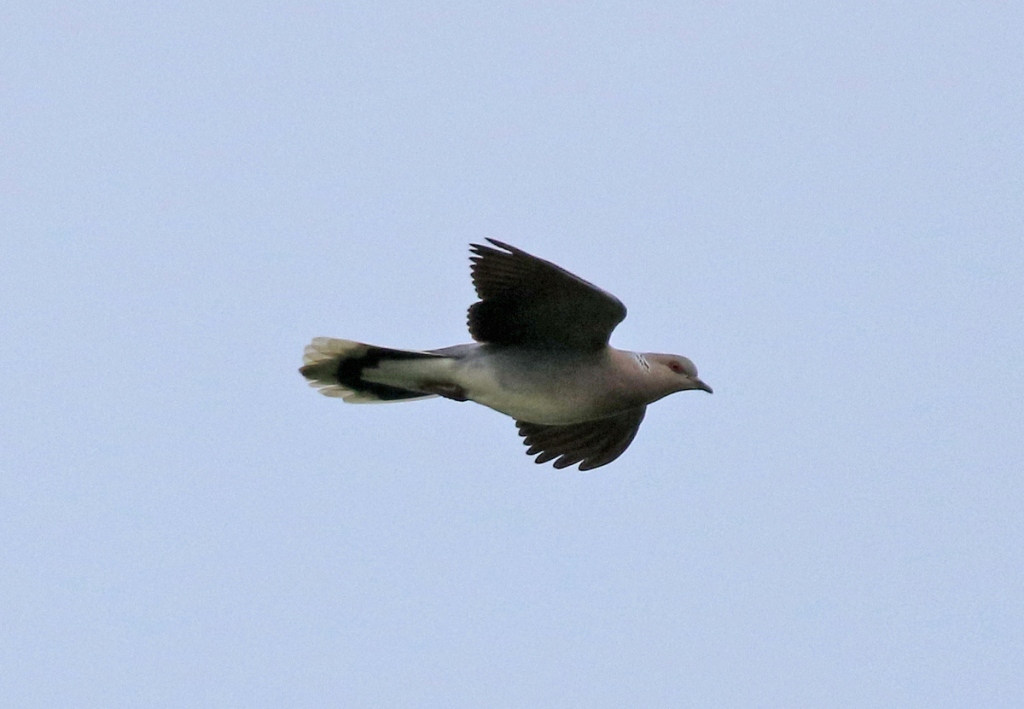
The Turtle Dove then flew back over the path again, this time landing in a large willow out of view. We could hear it but couldn’t see it. The next time it flew out, it headed off north away over the bushes out of sight.
We continued on, up onto the outer seawall. The tide was quite a way out still, but we stopped to scan the mud of the Wash. There were lots of waders out on the distant shoreline, predominantly Oystercatchers, plus one or two Curlews. A single lingering Brent Goose was out there too – most of the remaining birds seem to have departed in the last week or so, back to Siberia for the breeding season.
Dropping back down, we walked on up through the middle of the bushes. There were lots of Linnets here, some smart males with pinky red flushes on their breasts, and some brown streaked juveniles now too. A male Stonechat appeared on the top of a bush on the seawall. They bred here and sure enough just a little further up we found a couple of streaky juveniles too. A Meadow Pipit feeding on the short grass nearby was the first of the day.
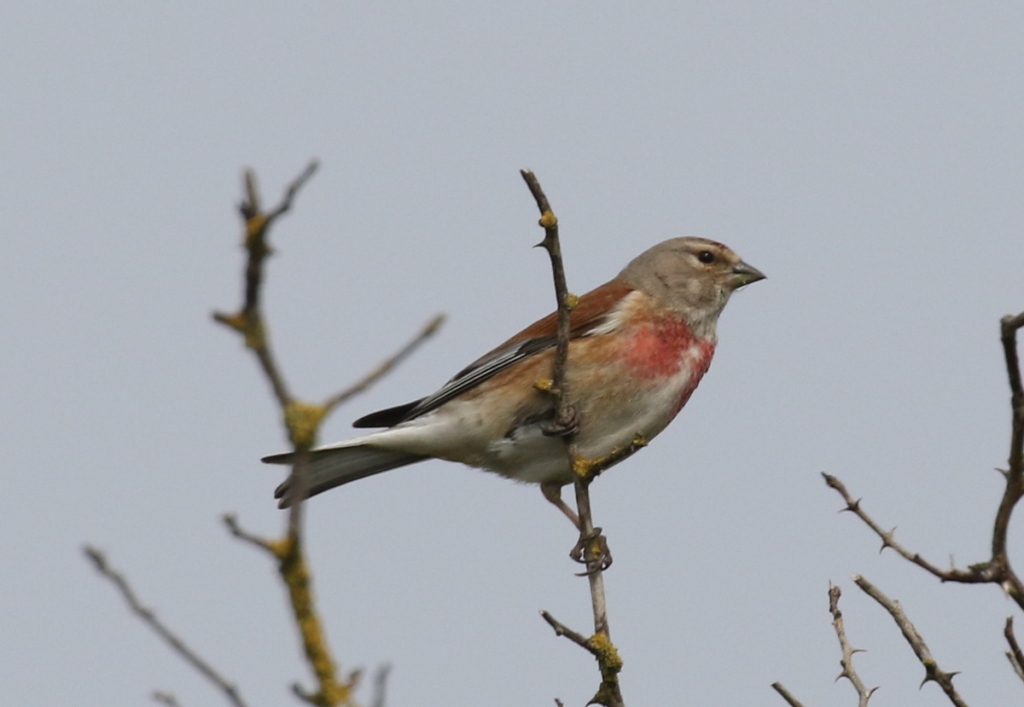
There was a nice selection of butterflies here again, despite a fresher breeze today – a couple of Wall, a Brown Argus, a Small Heath. A Mother Shipton, a species of day-flying moth, landed briefly in the grass but was off again before we could really see the supposed likeness of the 16th century witch on its wings, after which it is named.
Two more Turtle Doves flew past heading south, presumably a male and a female. A little later, we saw a male coming back the other way in display flight. We saw it land in the top of a large bush, where it started purring, so we took advantage to have another look through the scopes.
The tide was slowly coming in and we now and a succession of small groups of Oystercatchers flew in off the Wash, heading in to roost on the marshes just inland. We climbed up onto the outer seawall again, by the crossbank. There were more Curlews on the mud now and two Bar-tailed Godwits in the shallow water. We could see their slightly upturned bills, before they tucked them in and went to sleep. Two different Ringed Plovers were hunkered down on the top of the beach, incubating in the roped off cordon nearby. They were very hard to see, well camouflaged against the shingle.
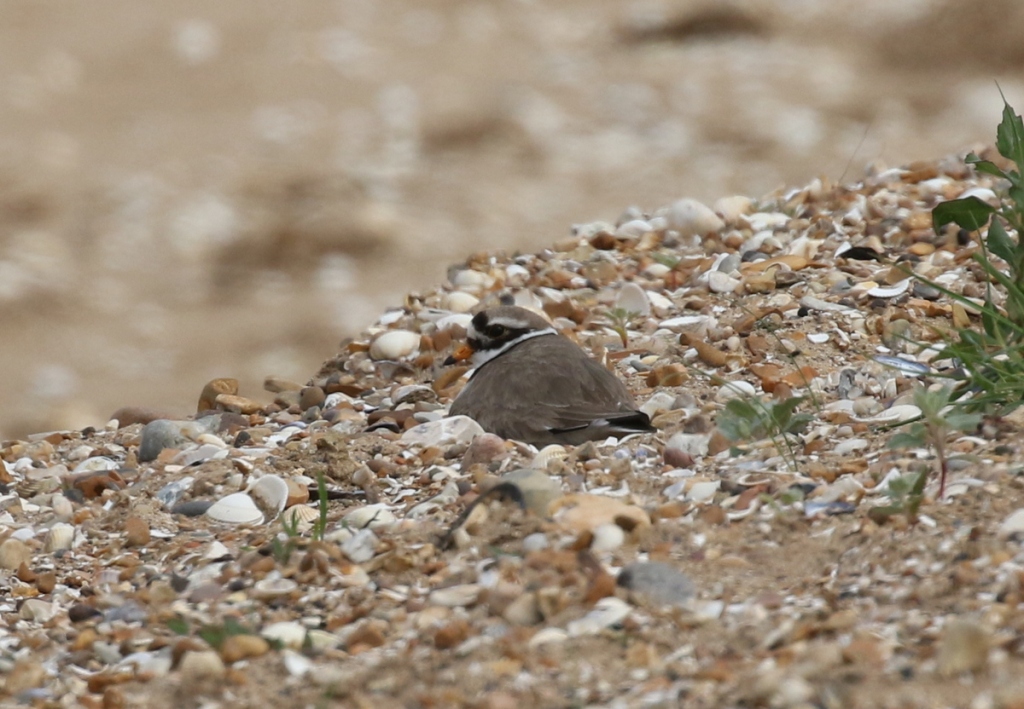
We walked across at the crossbank and climbed up onto the inner seawall to scan the marshes. We could see some distant Little Gulls on the pool away to our left, so we walked a short way further up for a better look. There were at least three, all immature (1st summer/2nd calendar year) with the black ‘w’ pattern across their wings. We could see lots of Black-headed Gulls nesting, and lots of 2nd calendar year Common Gulls roosting further back, along with a mixture of immature Herring Gulls of various ages and a single young Great Black-backed Gull. A Common Tern flew in, and landed on one of the islands.
There were a couple of waders on the small pool the other side, on the grazing marsh. We had good views of a very close Black-tailed Godwit, a bird with a limp which always seems to be on here. It didn’t look particularly well today.
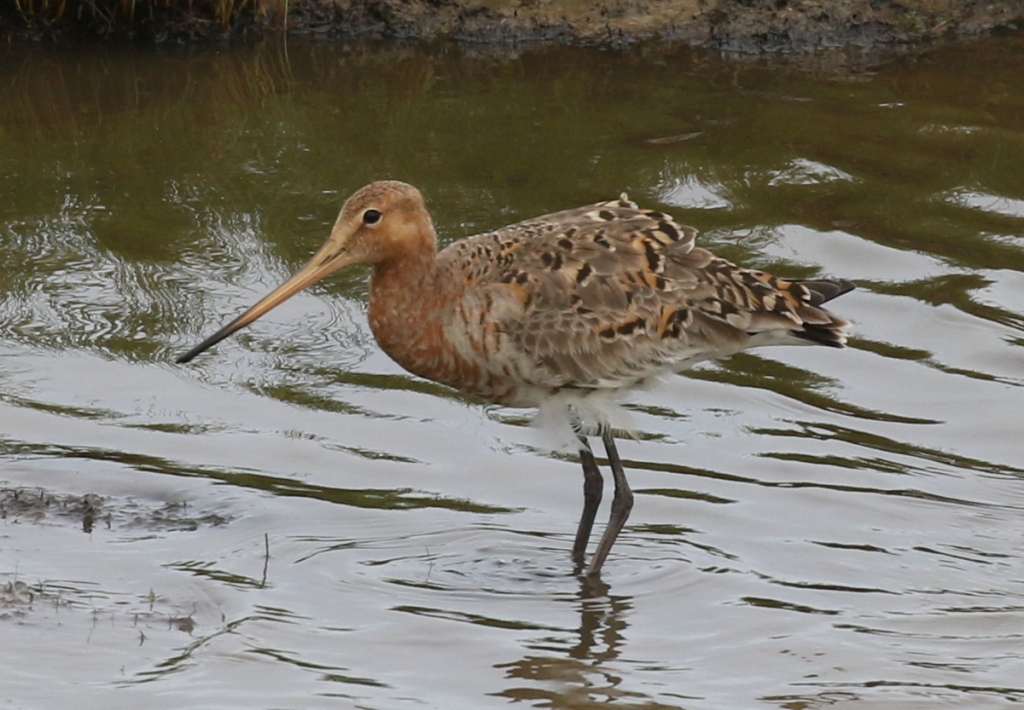
A lone Avocet on the mud looked to be incubating. At one point the other member of the pair flew in calling, and the first got up. It looked like they were performing a nest changeover but we couldn’t see an egg in the shallow scrape.
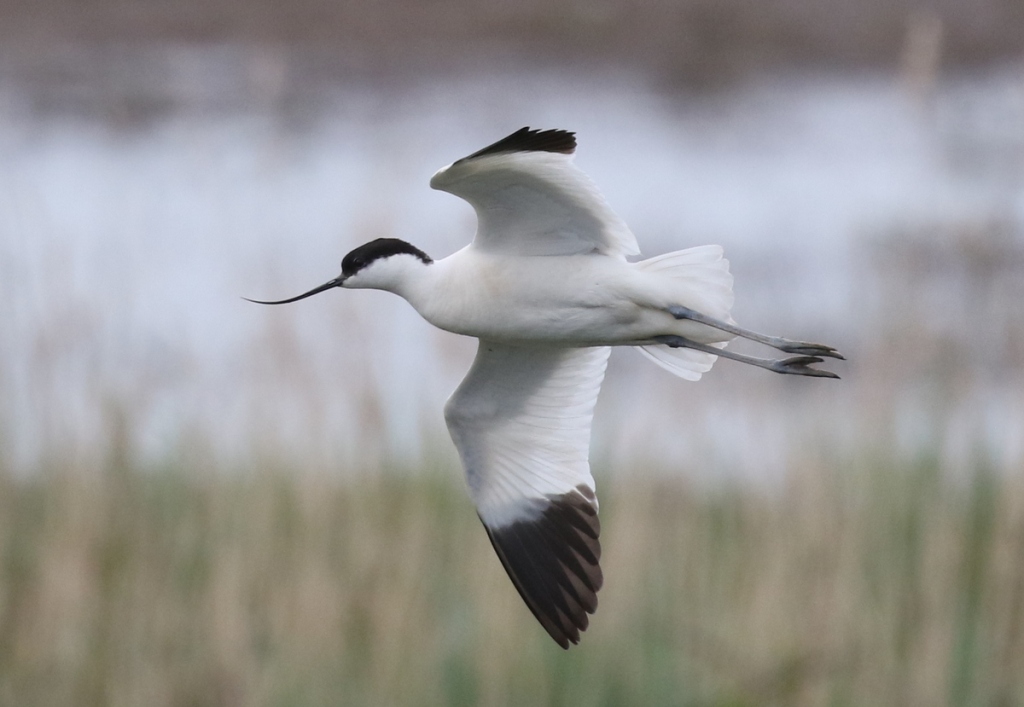
There were more Avocets and Lapwings out on the marshes. About fifty Black-tailed Godwits were roosting, Icelandic birds in various stages of moult, presumably mostly young birds which have not migrated back to Iceland to breed and not moulted fully into breeding plumage. A large mob of Oystercatchers was now roosting at the back, with more still flying in from the Wash. Two Spoonbills were mostly fast asleep (doing what they like to do best!), waking up and flashing their bills only briefly
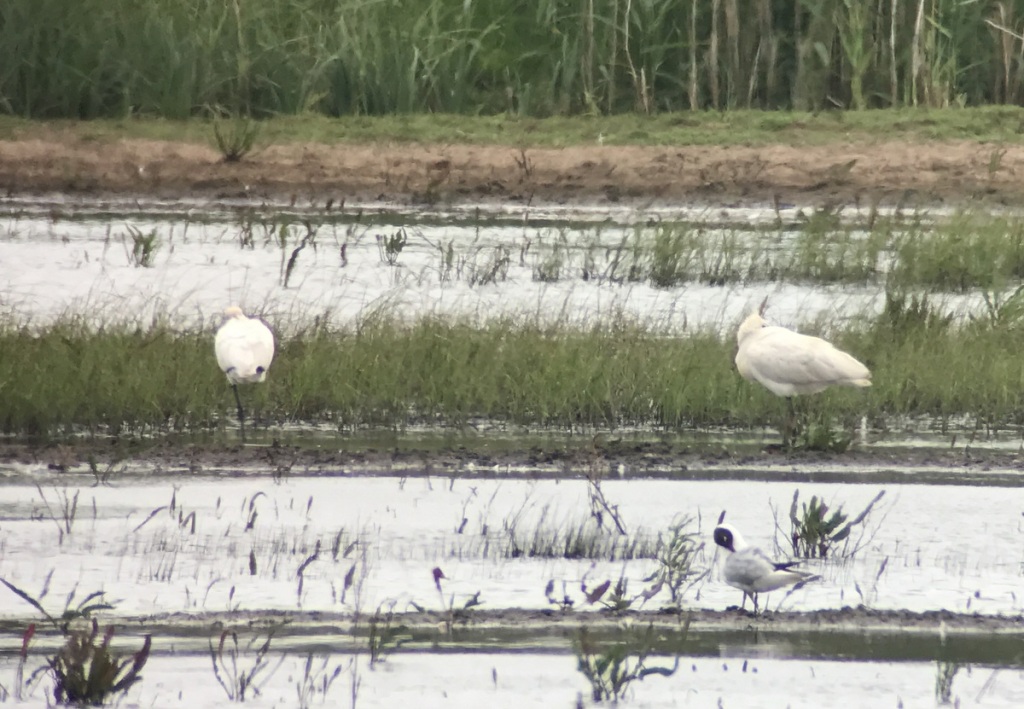
One or two Marsh Harriers flew over occasionally, attracting the ire of all the breeding gulls and waders, which chased up after it calling noisily. A Red Kite drifted over high.
There was a nice selection of ducks out here too, including a single lingering drake Wigeon, on the far bank with some Tufted Ducks. A pair of Mute Swans with just one cygnet swam out of the reeds in the channel below us. As we started to walk back, we scanned through the big flocks of geese – Greylags with lots of goslings, Canada Geese and a few Egyptian Geese – but all we could find different here today were three escaped Swan Geese (which don’t count unfortunately!).
Another Spoonbill was feeding actively in one of the pools among the geese, but disappeared into the rushes before we could get the scopes on it. It would have been nice to see one properly awake, but when we looked back it had climbed out onto the bank and gone straight to sleep! There were several Little Egrets, and two or three Grey Herons out here too.
It was just starting to cloud over now and lots of Common Swifts were hawking for insects low over the bushes, occasionally sweeping low past us, over the bank. A few House Martins appeared too, hard to tell if they are still migrants on the move or just local birds come for the feeding. A couple of Swallows were in with them too.
We headed over to Titchwell for lunch in the picnic area. Thankfully the rain held off. A Blackcap was singing in the trees nearby, and we could just see it flitting around. A Reed Warbler was singing in the sallows – it obviously hadn’t read the book!
After lunch, we decided to have a walk out on the reserve. It was forecast to rain, and we would have the option of shelter in the hides when it did. A smart male Marsh Harrier flew in over the reeds out at the back of the old Thornham grazing marsh pool. A Spoonbill flew in high over the Freshmarsh but carried on away over the west bank and the saltmarsh beyond
We stopped to listen at the reedbed, to see if we could hear a Bearded Tit. We didn’t, but we did see several Sedge Warblers and Reed Warblers flying back and forth. A Bittern boomed, but just twice before going quiet again. There were a few Common Pochard in the reedbed channels and a single Great Crested Grebe on the reedbed pool along with lots of Greylags and Gadwall.
It still wasn’t really raining much and there were lots of people in Island Hide already, so we scanned the Freshmarsh from the bank. We could see a small group of waders distantly in front of Parrinder Hide, several Ringed Plover and a lone Dunlin with them. A Little Ringed Plover was up on the back of the island just beyond, but it was hard to see any detail at this range, and it was very well camouflaged against the dry mud.
A couple of drake Teal were new for the day – another duck which is common here in the winter but not many remain right through the summer. A single adult Mediterranean Gull dropped in briefly to bathe. They seem to be much scarcer here this year, for some reason.

While the rain was holding off, we decided to head straight out to the beach and come back to the hide. There was nothing on Volunteer Marsh, so we carried on to the Tidal Pools where we found several Turnstones picking around the islands. A pair of Shelduck swimming across the water were followed by several shelducklings.
Out at the beach, the tide was coming in and was already half way up the sand. Scanning out to sea, we spotted a Little Tern away to the west, close in, just beyond the breakers. It was flying away west all the time and getting increasingly hard to see against the grey water, but then thankfully turned and came back, giving us a good view now as it flew east past us, just beyond the sand. A few minutes later, another Little Tern flew out over the beach carrying a fish and disappeared off over the water towards Scolt. One or two Sandwich Terns were offshore too, but rather more distant.
With the tide in, there was not much on the beach, but we could see a small flock of Sanderling on the sand half way to Brancaster. They were running around in front of the waves breaking on the beach, in typical Sanderling fashion, but were very different from the silvery grey and white birds we see in winter, being much darker now in their breeding plumage. A pitfall for the unwary!
It was spitting with rain now, so we turned and headed back. A Spoonbill was on one of the pools out on the saltmarsh now, feeding. It climbed up out of the pool it was in and walked slowly across the saltmarsh amongst the thrift to another one a little further over. Nice to finally see one properly awake!
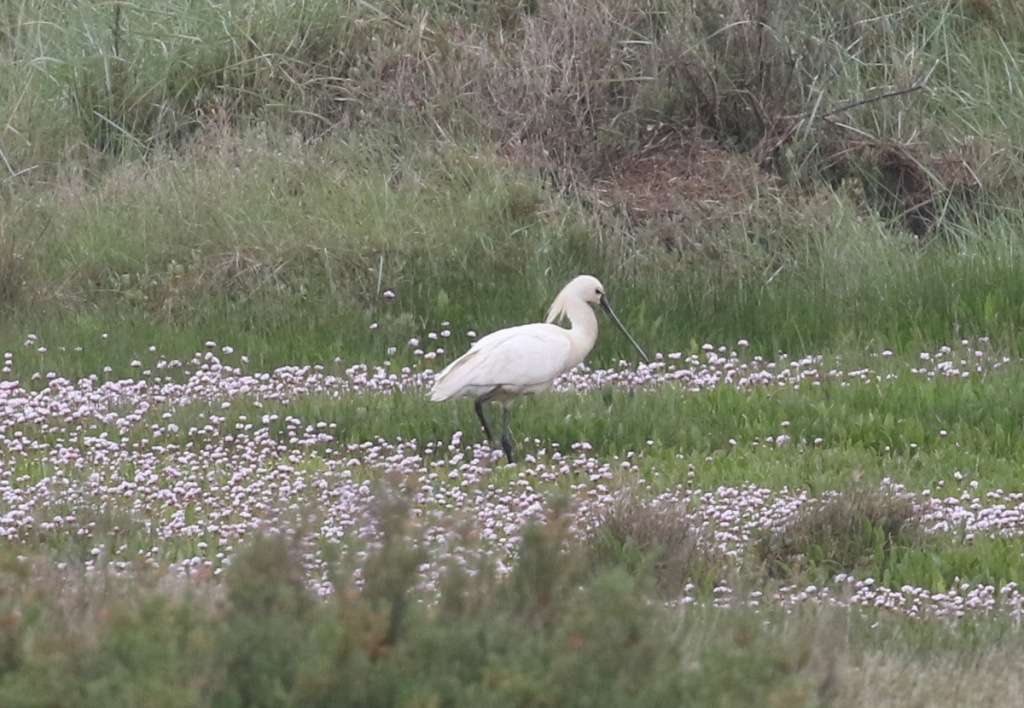
When we got back to the Freshmarsh, we turned down the path to Parrinder Hide. Just before we got in, we looked across to see a wader fly up from below the bank and land again on the island in front of the hide. A Common Sandpiper, a migrant here, possibly a late bird heading north or perhaps an early returning bird already which had failed to breed successfully. From the shelter of the hide, we watched as it worked its way right down to the front on the mud.
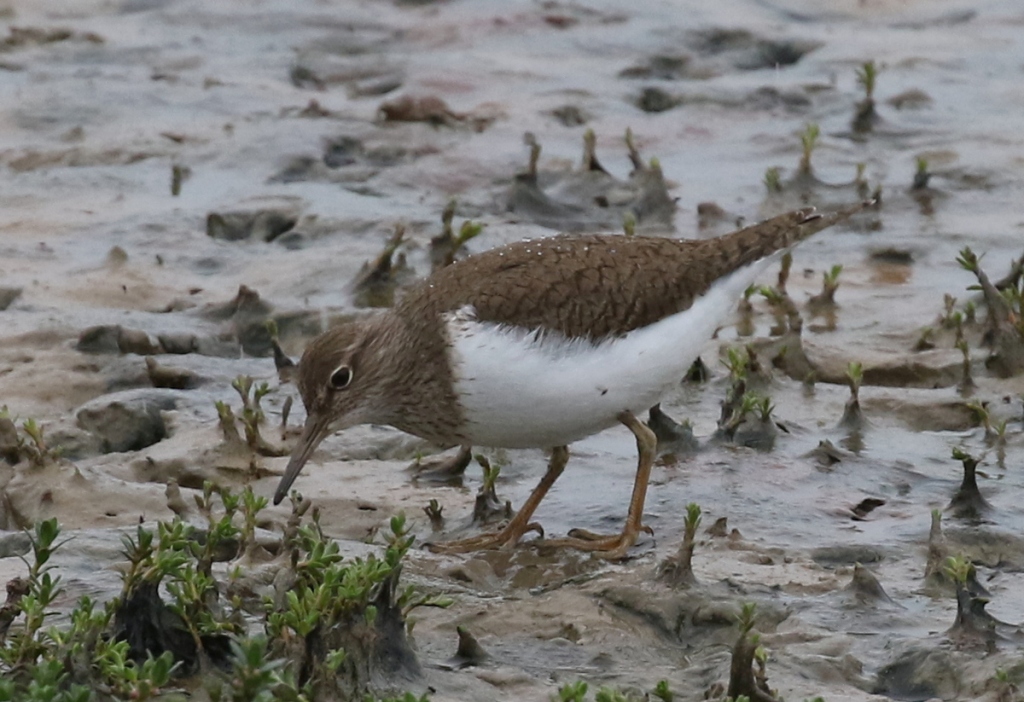
There were several Ringed Plovers out here still too, we counted twelve now. They came close in too, feeding on the mud right below us. They looked quite small and dark compared to our resident breeders, presumably migrant Tundra Ringed Plovers (of the subspecies tundrae) stopping off on their way north.
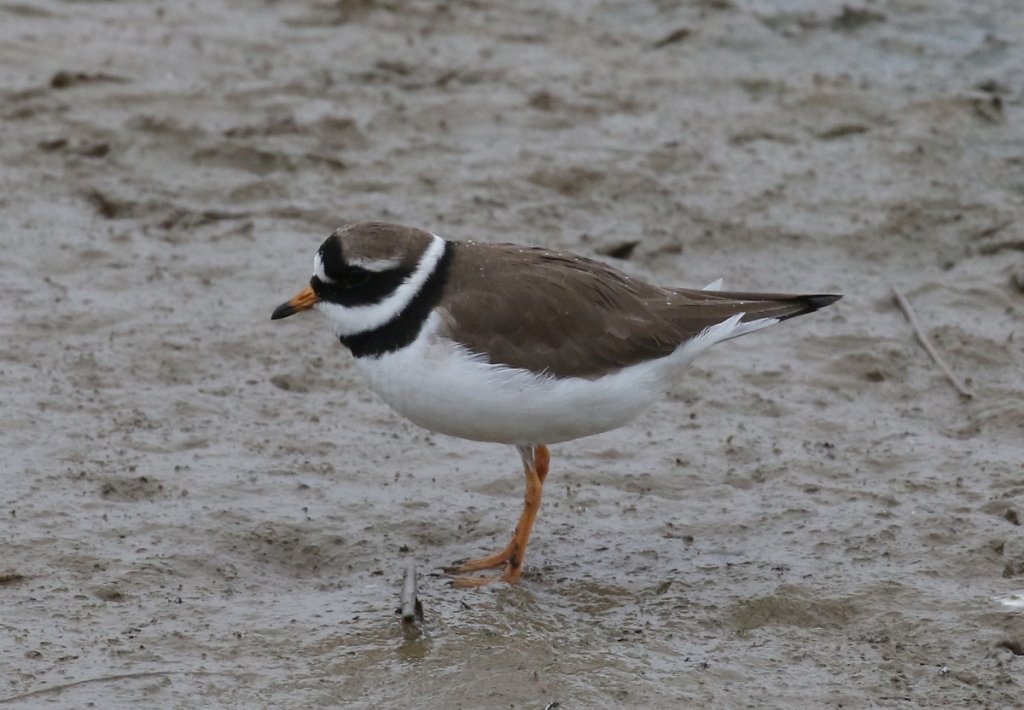
It was raining a little more heavily now, so we decided to sit it out and admire the waders. A male Redshank was displaying to a female further back, which was not showing much interest. A group of four Avocets gathered for a squabble in front of the hide.
A group of Black-tailed Godwits was busy feeding in the deeper water beyond the islands, mainly 1st summer Icelandic birds which had not gone north to breed. One was on its own a short distance from the others and looked noticeably bigger and longer-billed. It seemed to have a more contrasting pale face and the pale orange on its breast was not as deep as a full adult Icelandic Black-tailed Godwit. We got it in the scope and on closer inspection, noticed it was colour ringed and tagged. This was enough to confirm that it was a Continental Black-tailed Godwit, of the nominate limosa subspecies, rather than the islandica Icelandic Black-tailed Godwits which are more common here.
A quick check with one of the locals who collects colour-ring combinations from here and he was able to confirm immediately that it was one of the very small number Continental Black-tailed Godwits which breed in the UK, on the Ouse Washes. Apparently it failed in its breeding attempt this year, and has already moved to Titchwell to feed and moult. It seems like the UK Continental Black-tailed Godwits, which are already teetering on the edge, have suffered from flooding on the Ouse Washes this year after all the rain in May.

We had come to Parrinder Hide particularly hoping to see the Little Ringed Plover a bit closer, but we hadn’t seen it again yet. We had a careful scan round where it had been now and eventually found it hiding behind the bricks. It was preening, presumably taking advantage of the rain to have a shower. Eventually it came out and ran along the island over to the edge of the reeds, where we could get it in the scopes. Now we could see its golden yellow eyering properly.
The rain had helpfully eased off again now. It was time to head back – it had been a good start, but we had another busy day ahead tomorrow.
















